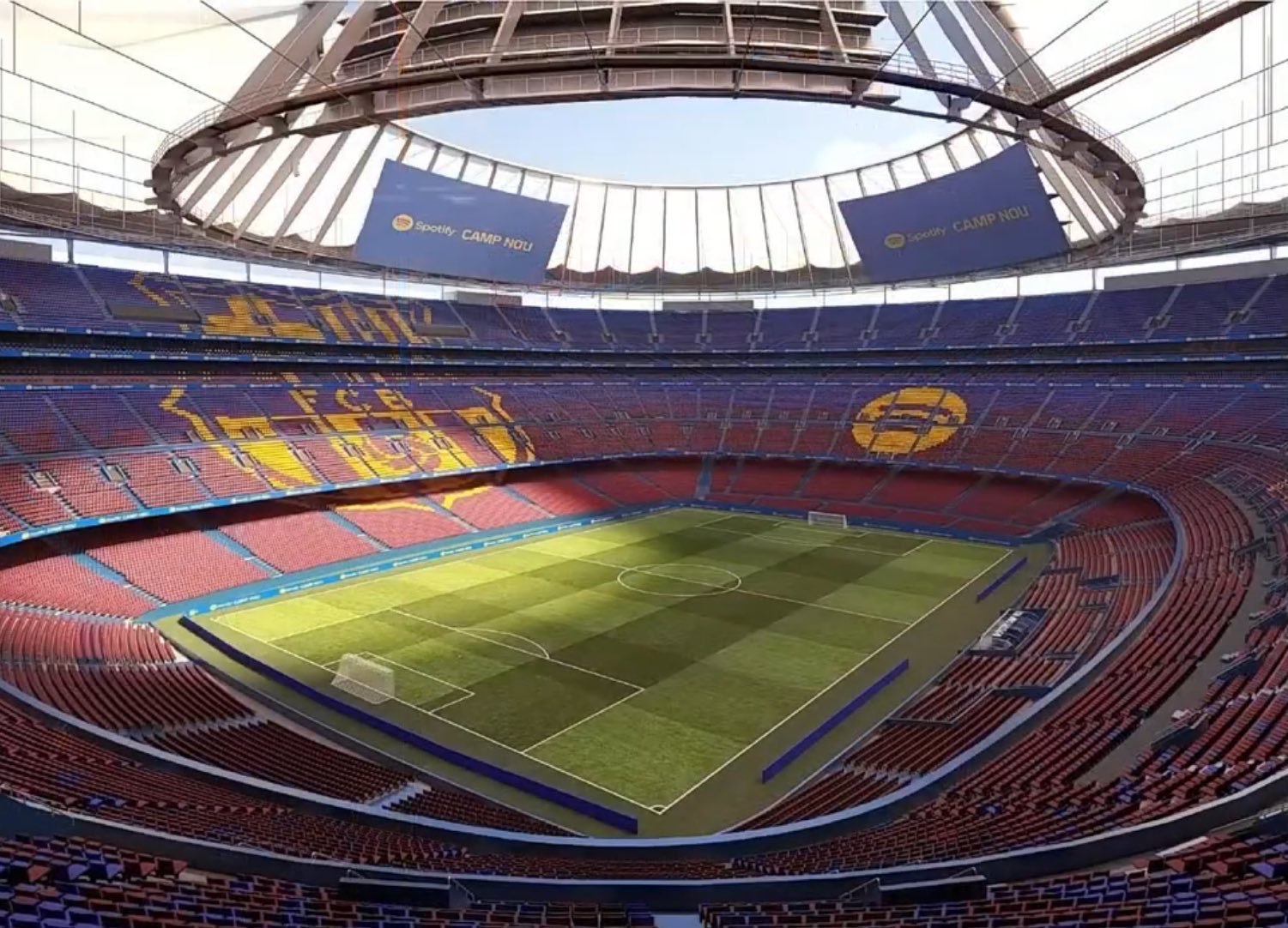Football’s beauty, attracting billions worldwide, lies in various aspects, among them, the vastness and diversity of stadiums globally. It’s no surprise that such a popular sport necessitates grand venues for the creation of unforgettable memories. However, certain stadiums surpass others in sheer size and magnitude, leaving an indelible impression on fans.
It’s always fascinating to explore the largest football stadiums globally. Would you like me to list the top 15 biggest stadiums in the world for you?
Below, we also list the biggest stadiums in the world from all sports, noting which have been used occasionally for football, even if they don’t regularly host football fixtures.
Football’s top 15 biggest stadiums in the world
15. Stade France
Location: Saint-Denis, France
Opened: 1998
Seating Capacity: 81,338
Construction Cost: €364m

Built ahead of the 1998 FIFA World Cup, the Stade de France hosted the tournament’s opening and final games. It has also hosted four UEFA Champions League finals (2000, 2006, 2022), and three Rugby World Cups (1999, 2007, 2023) and will host athletics during the 2024 Summer Olympics.
The Stade de France has a movable stand which unveils an athletics track without ruining the spectator experience during football games when supporters prefer to be closer to the pitch.
Despite its clear value as a football ground, no professional club plays its matches here regularly. Paris Saint-Germain spurned the opportunity to do so upon its construction in 1998. PSG have instead remained at the Parc des Princes.
Today, Stade France is regarded as the national stadium of France and so, apart from being a popular Champions League finals stadium, the venue does not only host football matches but also athletics, rugby and concerts. Stade France has a capacity of 80,000 seats and took nearly three years to build between 2 June 1995 and 28 January 1998. Moreover, Stade France was designed by Michel Macary, Michel Regembal, and Aymeric Zublena.
14. Signal Iduna Park
Location: Dortmund, Germany
Opened: 1974
Seating Capacity: 81,365
Construction Cost: €200 million in 2006

Signal Iduna Park is the home of German outfit Borussia Dortmund. Dortmund are undoubtedly one of the top European clubs and the 81, 365-seating-capacity Signa Iduna add to that flair.
Constructed back in 1974 to be one of the stadiums that hosted the 1974 World Cup, Signal Iduna Park has gone on to create a brand for itself. The stands are very close to the pitch and they make for an intimidating atmosphere to visiting teams and fans. The ground is also home to the largest free-standing stand among European stadiums, as it can hold 25,000 spectators on its own. This stand is also nicknamed the ‘Yellow Wall’.
Unlike most stadiums in Europe that have done away with the standing spaces, Signal Iduna Park still offers fans with the option of taking stand-only tickets. Over the years, there have been several modifications to the stadium that have brought down the original capacity. The standing areas have been reduced in favour of seated rows. As one of the largest stadiums in Europe, Signal Iduna Park was able to host several games during the World Cups in 1974 and 2006.
And let’s be honest, it’s pretty cool that the stadium is home to such a prestigious and successful team such as Borussia Dortmund too. So while this is slightly lower down on our list, the presence of standing fans certainly creates a unique vibe – and we hope things remain this way in the future.
13. Jakarta International Stadium
Location: North Jakarta, Indonesia
Opened: 2022
Seating Capacity: 82,000
Construction Cost: $312m

The home ground of Persija Jakarta and semi-regular home of Indonesia’s national side, this 82,000-capacity ground is the largest football-specific arena in Asia.
Furthermore, it’s the biggest football stadium in the world with a retractable roof, and the second largest stadium of any kind with a retractable roof, behind the Texan AT&T Stadium.
The ground hosted 16 matches at the 2023 FIFA U17 World Cup.
12. Estadio Santiago Bernabeu
Location: 1947
Opened: Madrid, Spain
Seating Capacity: 83,186
Construction Cost: €1.7 million (but recent renovation costs have soared to $1.5bn)

Another ground to undergo a significant renovation in recent times, the home of Real Madrid remains imposing in size and appearance, but now with an added spaceship-style exterior.
The Bernabeu, named after a former club president, has hosted four European Cup/UEFA Champions League finals (1957, 1969, 1980, 2010), the 2018 Copa Libertadores final, the 1964 Euros final and the 1984 World Cup final.
Spain’s second-largest stadium, Real Madrid have played at the Bernabeu since 1947.
Moreover, the home ground to Los Blancos is ranked highly among venues that have hosted the UEFA Champions League stadiums. A match at the Santiago Bernabeu always feels different, especially the UCL and El-Classico nights.
11. Estadio Monumental Antonio Vespucio Liberti
Location: Buenos Aires, Argentina
Opened: 1938
Seating Capacity: 83,198
Construction Cost: $3m (initial construction, several renovations since)

The home of Argentinian giants River Plate, the iconic El Monumental hosted the 1978 World Cup final and four Copa America finals, most recently in 2011.
Recent renovation work has removed the athletics track and expanded the capacity to in excess of 83,000. When the renovation is fully completed, the capacity will be 84,567. That work should be done in 2024.
10. Stadium Australia
Location: Sydney, Australia
Opened: 1999
Seating Capacity: 83,500
Construction Cost: A$690m

Currently known as the Accor Stadium for sponsorship reasons, Stadium Australia was built ahead of the 2000 Sydney Olympics. It was opened in March 1999 with a rugby league double-header which attracted 104,583 supporters. After the Olympics, the stadium was reconfigured, reducing its capacity to 80,000.
The largest ‘soccer’ stadium in Australia, this ground hosts crucial matches for the Socceroos, the Australian national football stadium. Furthermore, Sydney FC have played several fixtures at the ground, normally exhibition matches against foreign opponents. The A-League All-Stars have done the same.
In 2023, Stadium Australia hosted five matches at the 2023 FIFA Women’s World Cup, including the opening match and the final.
The ground is a multi-sports venue which also hosts rugby league, rugby union, cricket, Aussie rules football, Motorsports, American football, as well as music concerts. The Bee Gees were the first to perform with AC/DC, U2, Bon Jovi, Eminem, Taylor Swift, Guns N’ Roses, Adele, Justin Bieber, the Foo Fighters, Ed Sheeran, Red Hot Chilli Peppers, Harry Styles and The Weekend following. Coldplay are scheduled to play here in 2024.
9. Borg El-Arab Stadium
Location: Borg El Arab, Egypt
Opened: 2009
Seating Capacity: 86,000
Construction Cost: €200 million in 2006

This is the third largest stadium in the African continent as it only sits behind the FNB Stadium in terms of total capacity. It’s also behind the New Administrative Capital Stadium, which hasn’t yet hosted a game.
Until the latter is officially opened, the 86,000 capacity of the Borg El-Arab Stadium makes it the largest in Egypt by a comfortable margin. Unlike many other stadiums of its kind, it has been air-conditioned in many places so that the extreme weather conditions in this part of the world are combated with great efficiency. The designers have put in a massive effort to make sure that the stadium offers every type of facility – including two sub-stadiums with a capacity of 2,000 spectators.
The Egypt national football team call this stadium as the home. It recently made it to the history books after becoming the ground from where Egypt qualified to the World Cup for the first time since 1990. Apart from a football pitch, the Borg El-Arab Stadium also comes with running tracks and other sections for the Olympic Game activities.
You can just imagine the noise in this stadium too when players such as Mo Salah take to the field to represent the Egyptian national team. At full capacity, with more than 85,000 fans supported, it must be electric in there – although we’d imagine the seats that are covered in shade are like gold dust given the heat in this part of the world.
8. Bukit Jalil National Stadium
Location: Kuala Lumpur, Malaysia
Opened: 1998
Seating Capacity: 87,411
Construction Cost: RM800 million

The Malaysian national football team may not be high in the FIFA rankings, but that does not stop the national team from building one of the largest football stadiums in the world. The Bukit Jalil National Stadium, which was built at a cost of RM800 million, is a colossus that can hold more than 87,000 spectators. It is the largest stadium of its kind in Southeast Asia. Therefore, it does not come as a surprise that it has hosted many other events apart from the games of the Malaysia national team.
The Bukit Jalil National Stadium has been the host for the Commonwealth Games, Southeast Asian Games, and more. This multisport venue comes with a roof and it is largely constructed out of reinforced concrete. Despite being relatively new, major renovation works have already been carried out and they have brought in much-needed features like new facilities and LED lighting. More features are in the works as retractable seats, retractable roofs, and lifestyle facilities will also be included in the stadium as part of the upcoming renovation works.
As you can probably tell from the photo, this stadium is pretty high too, so with the retractable roof in full flow – this must make the stadium incredibly loud, vibrant, and awesome to play in. As stated before, Malaysia isn’t one of the most prestigious FIFA teams, but since this is one of the largest stadiums in the world, we’d imagine it is somewhat tricky for travelling teams!
7. Estadio Azteca
Location: Mexico City, Mexico
Opened: 1966
Seating Capacity: 87,525
Construction Cost: MXN$260 million

An iconic image in the Mexico City would be the Estadio Azteca, which is the home turf of the Mexican national team, Cruz Azul, and Club America. One of the major reasons behind the stadium being steeped in history is the prestige of having hosted two World Cup finals – 1970 and 1986. This stadium also witnessed one of the iconic moments in world football when Diego Maradona came up with the infamous ‘Hand of God’ goal against England in the 1986 World Cup.
Estadio Azteca is also widely regarded to have hosted the game between Italy and West Germany in 1970. This game is regarded as ‘Game of the Century’ and it witnessed Italy coming out on top with a 4-3 score after extra time. Estadio Azteca can go on to add more feathers in its cap considering that it is in line to host the games at the World Cup 2026. Apart from the World Cup, Estadio Azteca has also been the destination for Summer Olympics and the Women’s World Cup in the past.
The stadium has not shown its age even now, as frequent renovation works have consistently added new features like LED panels and new leisure spaces. In recent times, the addition of executive boxes has reduced the capacity down to the 87,000s.
If you were to contemplate visiting any stadium in Mexico, this one would definitely rank highly on the list – for all reasons previously mentioned. It’s a bit of a holy place for football in Mexico, and since it has hosted so many prestigious games in the past, the Estadio Azteca isn’t only one of the biggest, it’s one of the most iconic stadiums on this list.
6. Wembley Stadium
Location: London, England
Opened: 2007
Seating Capacity: 90,000
Construction Cost: £789 million in 2007

Wembley is an iconic destination for football fans in England. There was a lot of scepticism when the English Football Association decided to take down the original Wembley, known as the Empire Stadium upon its 1923 opening, which was regarded as the home of football, in favour of a new ground. This new stadium opened in 2007 at a whopping cost of almost £800 million. This would translate into a figure of £1.3 billion in current values.
Despite the extravagant cost, the new Wembley justified its image as one of the premier football destinations. Home of the England national team and all domestic finals in English football, it also hosts high-profile music concerts underneath its iconic arch.
The stadium hosts 90,000 under a non-retractable roof – making it the largest of its category Wembley has also a couple of UEFA Champions League finals and the UEFA EURO 2020 final, in which Italy beat hosts England.
5. Lusail Stadium
Location: Lusail, Qatar
Opened: 2021
Seating Capacity: 88,966
Construction Cost: Unknown

The second-largest football stadium in use in recent times, the 2022 World Cup host stadium will soon have its capacity reduced from 88,966 to 40,000 with the tournament now completed.
The Lusail Stadium hosted the 2022 World Cup final, as well as six group stage games and a fixture in each of the Round of 16, quarter-finals and semi-finals.
The construction of the ground came under scrutiny with investigations from several media outlets who alleged thousands of migrant workers had died during construction of World Cup venues in Qatar.
4. New Administrative Capital Stadium
Location: New Administrative Capital, Egypt
Opened: 2019
Seating Capacity: 93,940
Construction Cost: £40bn (total cost of sports complex – exact stadium cost unknown)
Expected to replace the Cairo International Stadium (75,000) as Egypt’s national football stadium, the New Administrative Capital Stadium – a hardly inspiring name – has been designed by Italian architects SHESA Architects and MJW Structures. These companies were also responsible for Turin’s Juventus Stadium and Cameroon’s Paul Biya Stadium.
While the name is uninspiring, the design is impressive, based on the headdress of the ancient Egyptian queen Nefertiti.
The stadium will sit at the heart of a larger sports complex with a training ground, indoor halls and an Olympic swimming pool. The construction of this ground is part of Egypt’s hope to host the 2030 World Cup – an aim already achieved – and the 2036 Olympic Games.
3. FNB Stadium
Location: Johannesburg, South Africa
Opened: 1989
Seating Capacity: 94,736
Construction Cost: $440 million

The FNB Stadium is the largest of its kind in Africa and it primarily hosts rugby union and football games. It can be quite an intimidating place given its size. The ground has been utilised for various purposes in the past, but it is best known for hosting the World Cup 2010 final match between Netherlands and Spain. The FNB Stadium is also the home ground for the South African national team, while also hosting the home games of domestic outfit Kaizer Chiefs.
The stadium is also quite special since it managed to feature the last public appearance of Nelson Mandela. Even though the stadium has been around since 1987, the major renovation work in 2010 for the World Cup brought about many new features like executive suites, a new roof, floodlights, and changing rooms. Apart from hosting the World Cup games, the FNB Stadium has also excelled in terms of hosting African Cup of Nations games. The FNB Stadium is also the most modern stadium in this part of the world.
Coming in at number three, it’s already quite clear that the FNB Stadium is one of the best there is, but the sheer size and aesthetics aren’t the star of the show, in our opinion. When you look back at games played here for the 2010 World Cup, the atmosphere was just incredible with the now-infamous vuvuzela echoing all over the stadium.
2. Camp Nou
Location: Barcelona, Spain
Opened: 1957
Seating Capacity: 99,354
Construction Cost: €1.73 billion

The Camp Nou hosts FC Barcelona and has a distinction as one of the largest stadiums in the world. It is easily the largest in Spain with its capacity touching almost 100,000. This is an impressive feat for an all-seater stadium. Over the years, the ground has managed to host every conceivable major tournament/game. It has been able to host games at the World Cup and EUROs as well as UEFA Champions League finals and the Summer Olympics (Barcelona hosted in 1992).
The iconic ground, which has never had a roof, allowing for a magnificent vista over the city as a whole, is undergoing major renovations now. That leaves FC Barcelona playing elsewhere. When the renovations are complete, the Camp Nou will have a roof and an even larger capacity.
1. Rungrado 1st of May Stadium
Location: Pyongyang, North Korea
Opened: 1989
Seating Capacity: 114,000
Construction Cost: Unknown

The world’s largest football stadium, the mysterious Rungrado 1st of May stadium in Pyongyang, North Korea takes up a space of almost 21 hectares. It is the home ground of the North Korean national football team but also hosts many other events.
Opened in 1989, little is known about the true details of this ground. It has a stunning roof with 16 concrete arches evocating a parachute – though they were designed to resemble a lotus blossom – and an enormous capacity of at least 115,000. There is some suggestion this could be an underestimation of how many supporters can fit in.
It’s pretty incredible, too, that the biggest stadium in the world was built as a petty response to neighbours South Korea constructing the Seoul Olympic Stadium. North Korea wanted to make a statement, and they did. How much it cost them isn’t known.
The ground is situated on Rungra Island, stands eight stories high and covers 207,000 square metres. Its name is derived from its opening date: May Day 1989.







